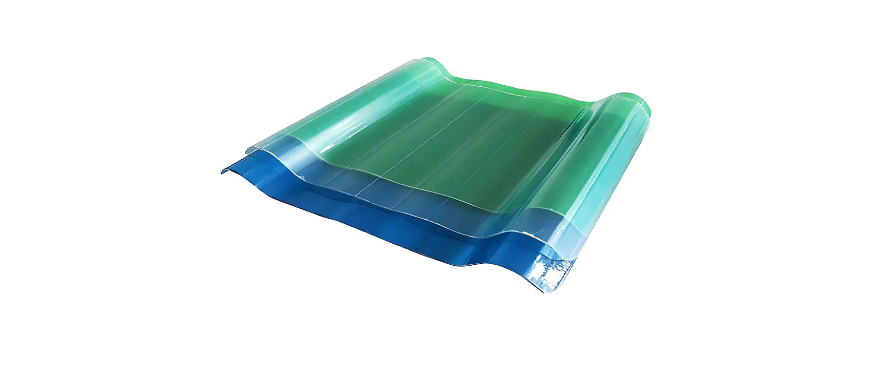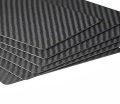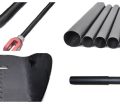
Fiberglass reinforced plywoods (FRP) is a composite material made by embedding fiberglass layers within traditional plywood, significantly improving its strength and durability. This reinforcement enhances the structural integrity of the plywood, making it more resilient to various stresses. The addition of fiberglass gives the plywood superior water resistance, making it ideal for use in moist or high-humidity environments. It also offers improved impact resistance, allowing the material to withstand heavy usage and physical stress. Furthermore, fiberglass reinforced plywood is highly versatile, with applications ranging from construction to automotive industries, where durability and reliability are essential. With these benefits, FRP becomes a preferred choice for demanding applications requiring long-lasting performance.
Types of Fiberglass Reinforced Plywood
Fiberglass reinforced plywoods (FRP) comes in various forms, each tailored for specific applications. These types leverage the combination of fiberglass and traditional plywood to enhance performance in demanding environments. Below are some of the most common types of fiberglass reinforced plywood panels and their unique features.
Fiberglass Reinforced Plywood Trailer Panels
Fiberglass reinforced plywood trailer panels are specifically designed for the construction of trailers, offering exceptional strength and durability. The addition of fiberglass to the plywood enhances its ability to withstand harsh weather conditions, physical impacts, and heavy use. These panels are particularly valued in the transportation industry, as they provide superior resistance to water and moisture, reducing the risk of rot and degradation. The material’s robustness makes it an ideal choice for trailers that require long-lasting, reliable performance in demanding environments.
Fiberglass Plywood Sandwich Panels
Fiberglass plywood sandwich panels are a composite material that combines layers of plywood with fiberglass to create a lightweight yet incredibly durable panel. This construction method improves both the strength and moisture resistance of the plywood, making it an excellent choice for transportation and industrial applications. The sandwich design allows the panel to retain its shape under pressure while offering enhanced insulation and soundproofing properties. These panels are commonly used in the construction of vehicles, storage facilities, and industrial walls where moisture resistance and durability are crucial.
GRP Plywood
GRP plywood is a specific type of fiberglass reinforced plywood that incorporates Glass Reinforced Plastic (GRP). GRP is known for its exceptional strength-to-weight ratio and resistance to environmental factors such as corrosion, UV radiation, and extreme temperatures. This makes GRP plywood an ideal material for a wide range of applications, including marine, automotive, and construction industries. The resilience of GRP plywood ensures it performs well even in harsh environments, offering long-lasting durability and reliability.
Top Benefits of Choosing a Fiberglass Oval Tub
Common Thicknesses of Fiberglass Reinforced Plywood
When selecting fiberglass reinforced plywood (FRP), the thickness of the material plays a crucial role in determining its strength, weight, and suitability for specific applications. The common thicknesses of fiberglass reinforced plywood vary, with each serving different functional needs. Below are the most frequently used thicknesses and their specific advantages.
3/4″ FRP Plywood
3/4″ fiberglass reinforced plywood is a popular choice for heavy-duty applications that require high strength and durability. This thickness provides the necessary robustness for structural elements such as flooring, walls, and load-bearing panels. Its increased thickness, combined with the fiberglass reinforcement, enhances its impact resistance and overall strength, making it ideal for environments where the material will experience significant wear and tear, such as in trailers, industrial equipment, and construction projects. The additional thickness also improves moisture resistance, which is crucial for areas exposed to high humidity or direct water contact. As a result, 3/4″ FRP plywood is often used in situations that demand both durability and long-term reliability.
1/2″ FRP Plywood
1/2″ fiberglass reinforced plywood is typically used for applications that require a balance between strength and weight. While thinner than the 3/4″ variant, it still offers enhanced durability compared to standard plywood due to the fiberglass reinforcement. This thickness is commonly used in applications where the material does not need to bear heavy loads but still requires increased resistance to moisture and impact. Common uses include vehicle interiors, storage units, and paneling in construction, where the material needs to be lightweight yet strong enough to withstand moderate stress. The 1/2″ thickness is often preferred when cost-effectiveness and ease of handling are priorities, while still benefiting from the added protection and longevity provided by fiberglass reinforced plywood.
Fiberglass Reinforced Plywood vs. Traditional Plywood
When comparing fiberglass reinforced plywood (FRP) to traditional plywood, the key differences stem from the additional fiberglass layers embedded within the plywood, which enhance its properties. While traditional plywood is a durable and cost-effective material, fiberglass reinforced plywood offers several advantages, making it more suitable for demanding applications. Below is a detailed breakdown of the differences and benefits.
Differences Between Fiberglass Reinforced Plastic (FRP) and Traditional Plywood
| Property | Fiberglass Reinforced Plywood | Traditional Plywood |
|---|---|---|
| Strength | Higher strength due to fiberglass layers. | Moderate strength, suitable for lighter loads. |
| Water Resistance | Excellent water and moisture resistance. | Susceptible to water damage and swelling. |
| Fire Resistance | Often treated for enhanced fire resistance. | Limited fire resistance, may catch fire easily. |
| Durability | More durable, resistant to wear and tear. | Less durable, prone to wear and environmental damage. |
| Maintenance | Requires minimal maintenance due to its resistance to moisture and rot. | Higher maintenance needed, especially in humid or wet conditions. |
| Weight | Heavier due to fiberglass reinforcement. | Lighter compared to FRP, but less durable. |
| Cost | Generally higher due to advanced materials. | Lower cost, more affordable for basic applications. |
Benefits of Fiberglass Reinforced Plywood
Fiberglass reinforced plywood offers several key advantages over traditional plywood, making it a preferred choice for applications that demand enhanced performance and reliability. These benefits include:
- Enhanced Strength: The addition of fiberglass gives FRP superior strength compared to traditional plywood, making it ideal for structural applications and heavy-duty uses.
- Water Resistance: FRP is highly resistant to water and moisture, preventing swelling, rotting, and warping, which is a common issue with traditional plywood in damp environments.
- Fire Resistance: Many types of fiberglass reinforced plywood are treated to be fire-resistant, providing an added layer of protection that traditional plywood lacks.
- Ease of Maintenance: FRP requires minimal maintenance due to its resilience to moisture, rot, and wear, unlike traditional plywood, which may need regular treatment to maintain its condition.
- Impact Resistance: Fiberglass reinforcement helps FRP withstand heavy impacts and physical stress, making it more durable than regular plywood in high-traffic or high-use areas.
Applications Where FRP Outperforms Traditional Plywood
Fiberglass reinforced plywood is often the material of choice in industries where strength, durability, and resistance to harsh conditions are critical. FRP outperforms traditional plywood in the following applications:
- Marine and Boat Construction: Due to its water resistance and durability, fiberglass reinforced plywood is commonly used in boat construction and marine environments, where exposure to moisture and saltwater is prevalent.
- Trailer and Vehicle Construction: The added strength and impact resistance make FRP an ideal material for trailers, vehicles, and transportation containers that require robust, long-lasting components.
- Industrial Panels and Flooring: In industrial settings, where materials are subjected to heavy wear and environmental stress, FRP is used for flooring, wall panels, and other structural elements.
- Construction in High-Humidity Areas: Fiberglass reinforced plywood is highly suitable for use in environments like bathrooms, kitchens, and outdoor structures, where moisture and humidity levels are high, and traditional plywood might warp or degrade.
In these applications, fiberglass reinforced plywood provides superior performance, offering enhanced longevity and reliability compared to traditional plywood.
Why Choose a Fiberglass Pedestal Tub for Bathrooms?
Applications of Fiberglass Reinforced Plywood
Fiberglass reinforced plywood (FRP) is a versatile material used in a wide range of applications across various industries. Its enhanced strength, durability, water resistance, and impact resistance make it an ideal choice for demanding environments. Below are some of the key applications of fiberglass reinforced plywood and how it excels in each area.
Fiberglass Reinforced Closed-Cell Foam Panels
Fiberglass reinforced closed-cell foam panels are used in both construction and vehicle applications, offering a combination of insulation, strength, and impact resistance. The closed-cell foam layer, reinforced with fiberglass, enhances the overall rigidity and insulating properties of the material, making it particularly effective for applications that require thermal insulation as well as structural integrity. These panels are commonly used in:
- Construction: In buildings, particularly in areas that require soundproofing or thermal insulation, fiberglass reinforced closed-cell foam panels are used for wall panels, floors, and roofs. Their resistance to moisture and mold makes them ideal for humid or high-moisture environments, such as bathrooms, kitchens, and basements.
- Vehicles: In automotive, RV, and trailer construction, these panels are used for interior walls, roofs, and flooring. The combination of lightweight foam and strong fiberglass reinforcement helps reduce vehicle weight while providing added impact resistance and insulation, improving energy efficiency and comfort.
By combining fiberglass with closed-cell foam, these panels provide both strength and energy efficiency, making them a preferred material for energy-conscious builders and manufacturers.
Fiberglass Composite Panels
Fiberglass composite panels are another key application of fiberglass reinforced plywood. These panels combine fiberglass with other materials to achieve enhanced properties, such as lightweight construction, high strength, and resistance to environmental factors. These composite panels are commonly used in industries such as furniture making, RV construction, trailer building, and mobile homes.
In the furniture industry, fiberglass composite panels are used to create durable, lightweight, and moisture-resistant components such as tabletops, cabinet doors, and shelving units. Their ability to withstand wear and tear, combined with their resistance to rot and water damage, makes them ideal for both indoor and outdoor furniture applications.
For RVs and trailers, fiberglass composite panels are employed for walls, roofs, and floors. The lightweight yet strong nature of these panels helps reduce the overall weight of the vehicle, making it easier to tow and more fuel-efficient, while still maintaining durability and strength to handle the rigors of travel.
In mobile homes, fiberglass composite panels are used for exterior cladding, interior panels, and structural components. The combination of fiberglass’s strength and the lightweight composite material ensures that mobile homes are both durable and efficient, with improved insulation and weather resistance.
In all these applications, fiberglass reinforced plywood composite panels provide the perfect balance of strength, versatility, and moisture resistance, making them a preferred choice for industries where performance and reliability are critical.
E-Screen Fabric Core Fiberglass: The Ultimate Solar Solution
Advantages of Fiberglass Reinforced Plywood
Fiberglass reinforced plywood (FRP) offers several key advantages over traditional plywood and other materials, making it a preferred choice for various industries. The combination of fiberglass and plywood results in a highly functional material that excels in durability, strength, and versatility. Below are the primary advantages of using fiberglass reinforced plywood.
Durability
One of the most significant advantages of fiberglass reinforced plywood is its outstanding durability. The incorporation of fiberglass layers significantly enhances the strength of the plywood, allowing it to withstand harsh environmental conditions. Some of the specific durability benefits include:
- Water Resistance: Fiberglass reinforced plywood is highly resistant to water, making it ideal for applications in damp or wet environments, such as RVs, trailers, and mobile homes. It does not absorb moisture, preventing the material from swelling, warping, or rotting over time.
- Mold and Mildew Resistance: Unlike traditional plywood, which can be susceptible to mold and mildew growth, fiberglass reinforced plywood resists these issues. This makes it a suitable material for applications where moisture exposure is frequent, providing long-lasting performance in humid environments.
- Enhanced Longevity: The fiberglass reinforcement protects the plywood from physical wear, ensuring that it maintains its strength and appearance over an extended period. This makes it an excellent choice for high-traffic areas, industrial applications, and outdoor use where other materials might deteriorate quickly.
Lightweight yet Strong
Fiberglass reinforced plywood provides a unique combination of lightweight construction and exceptional strength. Unlike traditional plywood, which can be bulky and difficult to handle, FRP plywood offers the following benefits:
- Ease of Handling and Installation: The reduced weight of fiberglass reinforced plywood makes it easier to transport, handle, and install, saving both time and labor costs during construction or assembly. This is especially beneficial in industries such as automotive and construction, where efficiency is key.
- Strength without Extra Weight: While fiberglass reinforced plywood is lightweight, it still delivers superior strength compared to regular plywood. This makes it a preferred material for applications requiring high strength but where reducing weight is important, such as in vehicle manufacturing or portable structures.
Cost-Effectiveness
Despite its enhanced properties, fiberglass reinforced plywood remains a cost-effective solution for many applications. The material provides excellent value for its price due to the following factors:
- Long-Term Savings: Although the initial cost of fiberglass reinforced plywood may be higher than traditional plywood, its durability and low maintenance requirements can lead to significant savings over time. It is less likely to need repairs or replacements, which makes it a more economical choice in the long run.
- Versatility in Use: The material’s ability to be used in a wide range of applications—from construction and furniture making to marine and transportation—means that it can replace multiple other materials. This versatility adds to its cost-effectiveness, as it reduces the need for specialized materials.
- Lower Maintenance Costs: Because fiberglass reinforced plywood is resistant to moisture, mold, and wear, it requires minimal maintenance. This makes it an ideal solution for environments where maintenance costs would otherwise be high, such as in RVs, mobile homes, and industrial facilities.
Fiberglass reinforced plywood offers significant advantages in terms of durability, strength, and cost-effectiveness, making it an ideal choice for a wide range of applications where traditional plywood might fall short.
FAQs about Fiberglass Reinforced Plywood
Fiberglass reinforced plywood (FRP) is a composite material made by layering fiberglass within traditional plywood. This combination results in a much stronger, more durable product that offers superior resistance to moisture, mold, and wear compared to standard plywood. The fiberglass provides added strength, impact resistance, and enhanced durability, making FRP ideal for demanding applications such as in trailers, boats, and construction materials. FRP is often used in environments where traditional plywood would degrade quickly, such as high-humidity areas, outdoor structures, or heavy-duty flooring. Additionally, FRP is highly resistant to chemicals, UV radiation, and fire, depending on its specific treatment, making it suitable for a wide range of industrial, transportation, and residential uses. The reinforced plywood is often more expensive than regular plywood, but its long-lasting performance justifies the investment in environments where durability and reliability are paramount.
A cheaper alternative to fiberglass reinforced plywood (FRP) would be standard plywood, which is less expensive but does not offer the same durability and resistance that FRP provides. Traditional plywood is widely used in construction and furniture, as it is lightweight and cost-effective. However, it is more vulnerable to water damage, mold growth, and wear over time compared to FRP. For applications where cost is a primary concern and the enhanced properties of FRP are not required, marine plywood or pressure-treated plywood may be an alternative. These materials are treated to improve their water resistance and strength compared to regular plywood, but they still do not offer the same level of protection or longevity as fiberglass reinforced plywood. For industries needing a balance between cost and performance, certain plastic laminates or resin-based materials may also serve as alternatives, though these often lack the same structural integrity as FRP.
The cost of fiberglass reinforced plywood (FRP) can vary depending on factors such as thickness, size, and the specific type of fiberglass used. On average, the price of FRP ranges from $2 to $6 per square foot. Thicker panels or those with specialized treatments, such as fire resistance or UV protection, can push the price higher. For example, high-quality FRP used in marine, industrial, or high-traffic applications can cost closer to the higher end of this range. Prices may also fluctuate based on the supplier, the region, and the quantity purchased, with larger orders often qualifying for bulk discounts. It’s important to consider that while FRP might have a higher upfront cost compared to regular plywood, its durability and long-term performance can result in significant savings in maintenance and replacement costs. If you’re planning a project with FRP, it’s advisable to check with suppliers for the latest prices and available options based on your specific needs.
Fiberglass reinforced plywood (FRP) is more expensive than traditional plywood primarily due to the materials used in its production and the enhanced properties it offers. The process of integrating fiberglass into plywood involves more advanced manufacturing techniques and materials. Fiberglass itself, a lightweight yet strong material, is produced through a specialized process that contributes to its cost. Additionally, the reinforcement process increases the overall manufacturing time and labor costs. The added strength, water resistance, impact resistance, fire resistance, and durability of FRP contribute to its higher price tag, as these qualities make it ideal for demanding applications like trailers, marine environments, and industrial uses. Furthermore, FRP is treated for additional benefits such as UV protection, mold resistance, and increased longevity, all of which add to the material’s overall value. While it may be more expensive initially, the reduced need for maintenance and longer lifespan of FRP often make it a more cost-effective choice in the long term for applications requiring durability and performance under challenging conditions.

As the editor of GangLong Fiberglass, I have years of experience and in-depth research, focusing on cable tray products, fiberglass solutions, and grille systems. I incorporate years of industry insights and practical experience into every content, committed to promoting the progress of the industry. At GangLong Fiberglass, my commitment is reflected in every product, from innovative cable trays to durable fiberglass solutions and sturdy grille systems. As an authoritative voice in the industry, my goal is to provide valuable information to professionals and businesses and promote forward-looking solutions.


